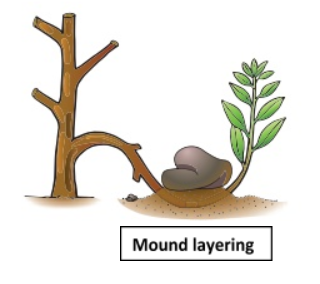
The stem branch used in layering is the-
A. Upper branch
B. Young branch
C. Soft basal branch
D. Hard basal branch
Answer
573k+ views
Hint: It is a common means of vegetative propagation, in which the root system is artificially induced into the stem when it is attached to the parent plant.
Complete answer: Layering is the process of development of roots on a stem while the stem is still attached to the parent plant.
1. Some plants can naturally propagate through layering.
2. This happens when a branch of the parent plant touches the ground and from that part of the ground, new adventitious roots are formed.
This can be understood through the following diagram.

3. This layering can also be achieved artificially. In this method, layering is done by wounding the stem of the plant, where roots are to be formed.
4. The plants in which the branched stems are heavy and closely spaced, i.e., one having fruits are layered by using the mound layering method. In this method, the plants nearer to the soil level are cut, when they are not growing.
5. New shoots are produced from dormant buds, present on the stem.
6. These new shoots are soft basal branches of that stem.
7. When we cover these shoots with a mound of soil, we can find roots are growing from the base of those shoots.
So, the correct option is C.
Note: Layering is important for plants in which the formation of roots takes place slowly. This method is frequently used in bonsai propagation.
This method can be also used for creating new roots by improving the existing ones.
Complete answer: Layering is the process of development of roots on a stem while the stem is still attached to the parent plant.
1. Some plants can naturally propagate through layering.
2. This happens when a branch of the parent plant touches the ground and from that part of the ground, new adventitious roots are formed.
This can be understood through the following diagram.

3. This layering can also be achieved artificially. In this method, layering is done by wounding the stem of the plant, where roots are to be formed.
4. The plants in which the branched stems are heavy and closely spaced, i.e., one having fruits are layered by using the mound layering method. In this method, the plants nearer to the soil level are cut, when they are not growing.
5. New shoots are produced from dormant buds, present on the stem.
6. These new shoots are soft basal branches of that stem.
7. When we cover these shoots with a mound of soil, we can find roots are growing from the base of those shoots.
So, the correct option is C.
Note: Layering is important for plants in which the formation of roots takes place slowly. This method is frequently used in bonsai propagation.
This method can be also used for creating new roots by improving the existing ones.
Recently Updated Pages
Master Class 12 Business Studies: Engaging Questions & Answers for Success

Master Class 12 Economics: Engaging Questions & Answers for Success

Master Class 12 English: Engaging Questions & Answers for Success

Master Class 12 Maths: Engaging Questions & Answers for Success

Master Class 12 Social Science: Engaging Questions & Answers for Success

Master Class 12 Chemistry: Engaging Questions & Answers for Success

Trending doubts
What is meant by exothermic and endothermic reactions class 11 chemistry CBSE

Which animal has three hearts class 11 biology CBSE

10 examples of friction in our daily life

One Metric ton is equal to kg A 10000 B 1000 C 100 class 11 physics CBSE

1 Quintal is equal to a 110 kg b 10 kg c 100kg d 1000 class 11 physics CBSE

Difference Between Prokaryotic Cells and Eukaryotic Cells




